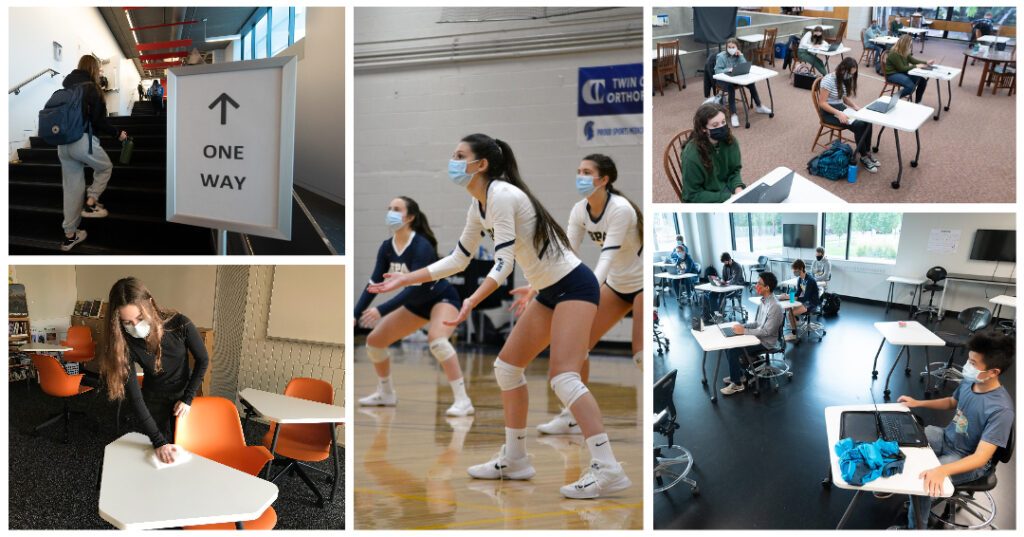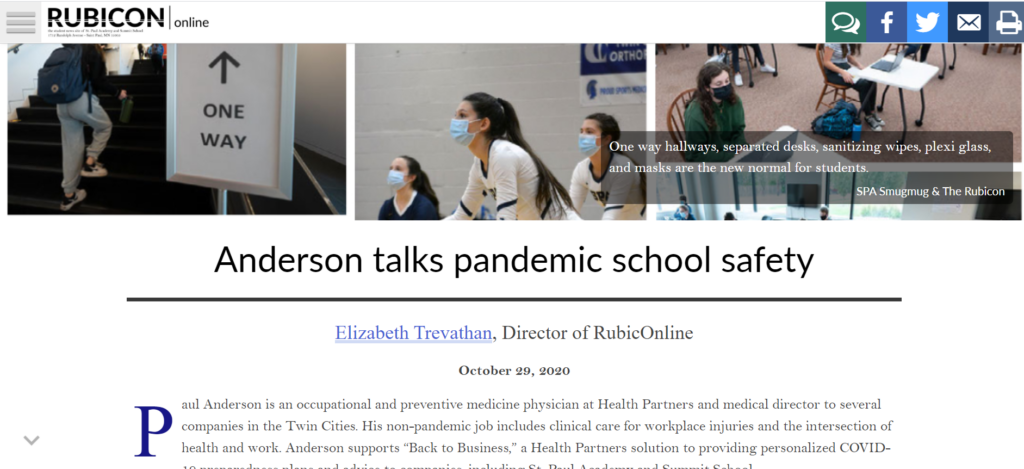October 29, 2020 – RubicOnline
Paul Anderson is an occupational and preventive medicine physician at Health Partners and medical director to several companies in the Twin Cities. His non-pandemic job includes clinical care for workplace injuries and the intersection of health and work. Anderson supports “Back to Business,” a Health Partners solution to providing personalized COVID-19 preparedness plans and advice to companies, including St. Paul Academy and Summit School.
Anderson said, “[…] responding to infectious disease pandemics is not very common. So, my normal duties don’t really include infectious disease outbreaks or pandemic response, but I have been trained to do that in the past.” He worked with the Centers for Disease Control, where he investigated outbreaks during the 2009 Swine Flu Pandemic.
St. Paul Academy and Summit School is extremely, extremely aggressive and well prepared, relative to other schools that I’ve seen.
Anderson
Anderson, Head of School Bryn Roberts, and Assistant Head of School for Students Jill Romans designed the COVID-19 safety plan off of the Hierarchy of Controls from the Occupational Safety and Health Administration and the five Ws of descriptive epidemiology, as explained by the CDC. The five Ws of descriptive epidemiology questions who the people are, how people move around and use the space when people are in the building, and when they are not in the building. Anderson then introduced the Hierarchy of Controls to the campus to reduce the risk of COVID-19 infections.
Anderson said, “In general, schools are considered a medium risk for exposure to COVID-19, so hospitals are a very much higher risk for exposure because there’s obviously people there who have COVID-19 who are being cared for. But in a school environment, the risk of getting exposed is significantly lower.”
At the top of the Hierarchy of Controls is eliminating the threat, which is completed through people staying home when they feel sick, before school screenings, and temperature screenings. “It’s very unlikely that there is actually an infected person in the school environment at any given time,” Anderson said.
Currently, if somebody believes that they’ve been exposed to COVID-19, they would answer the daily health screening in the Magnus Health App and receive a STOP. They are then expected to stay home to quarantine and participate in distance learning. If somebody does receive a positive COVID-19 test, they will engage in distance learning, if they can, and the school would perform contact tracing to inform possible exposed students.
The next stage is engineering; Anderson and the team at SPA increased the amount of air removed and fresh air introduced to the school throughout the day. “If there was an infected person, you would want to remove as much of the virus particles as you could from that room. Or you would want to have such a big room that those particles would be so spread out so that if someone came into contact with those particles, there wouldn’t be enough of them to get them sick,” Anderson said.
The next level is administration control, where they de-densified areas to ensure that only a certain number of people are using a room at a given time. The last class of the hierarchy is the personal protective equipment, which includes plexiglass shielding and masking. Anderson said, “If all of the other layers of protection did not work, then we are also reducing the likelihood that a sick person is putting the virus into the air by having them wear a mask and by using barriers to prevent the respiratory droplets from being spread around.”
In general, people are really kind of tired right now. They’re tired of all of the masking and social distancing and all the restrictions that are on their lives, relative to coronavirus.
Anderson
While crowded areas and areas where people are not required to wear a mask are a slightly higher risk, the goal is to have other layers of protection such as plexiglass shields and proper ventilation to keep everyone safe.
Anderson said, “Each organization […] will have its own risk tolerance. And so some organizations really don’t want to take a lot of risks of having a big outbreak in their school; and so they are a little bit more cautious than others, and frankly, St. Paul Academy and Summit School is extremely, extremely aggressive and well prepared, relative to other schools that I’ve seen. They have really done a lot of hard work to prepare their environment for safety.”
Looking to the next few months, Anderson is most concerned about household exposures. Since he began following the pandemic in January, he found the most critical place for infections to be in households. As winter approaches, people spend more time indoors and around each other; there’s less fresh air ventilation in their homes, and gatherings around holidays increase, so household transmissions increase and the community’s risk of transmission. Anderson said, “In general, people are really kind of tired right now. They’re tired of all of the masking and social distancing and all the restrictions that are on their lives, relative to coronavirus. And so people are tending to not be as careful. I think all of these reasons contribute to the increases in cases we’re seeing in particular in Minnesota, but also in the midwest.”
Anderson believes that schools are not the cause of the increase of COVID-19 infections. Due to the mitigation efforts, schools are not a hotspot for transmissions. He said, “In other words, people aren’t coming to school and infecting each other. And that’s really a testament to all these mitigations, or protective strategies […]; that they’re really making it hard for coronavirus to spread in St. Paul academies facilities. So even if somebody gets sick at home and they come to school, and they’re not feeling well, the way you’re doing school really makes it hard for the virus to spread from one student to the next, and that’s really the way that I’m seeing things unfold for several schools in the area.”
The school was informed on Monday of a positive case in the Upper School. In an email to the Randolf Campus, Community, Principal Max Delgado said, “The risk of exposure for other individuals present in the building on that date is no greater than the risk of contracting the virus in the general community. [Minnesota Department of Health] indicated that this is a low-risk community exposure.”
As per protocol, they worked with the MDH to contact trace students who were in close contact with the sick student.

SPA Smugmug & The Rubicon
